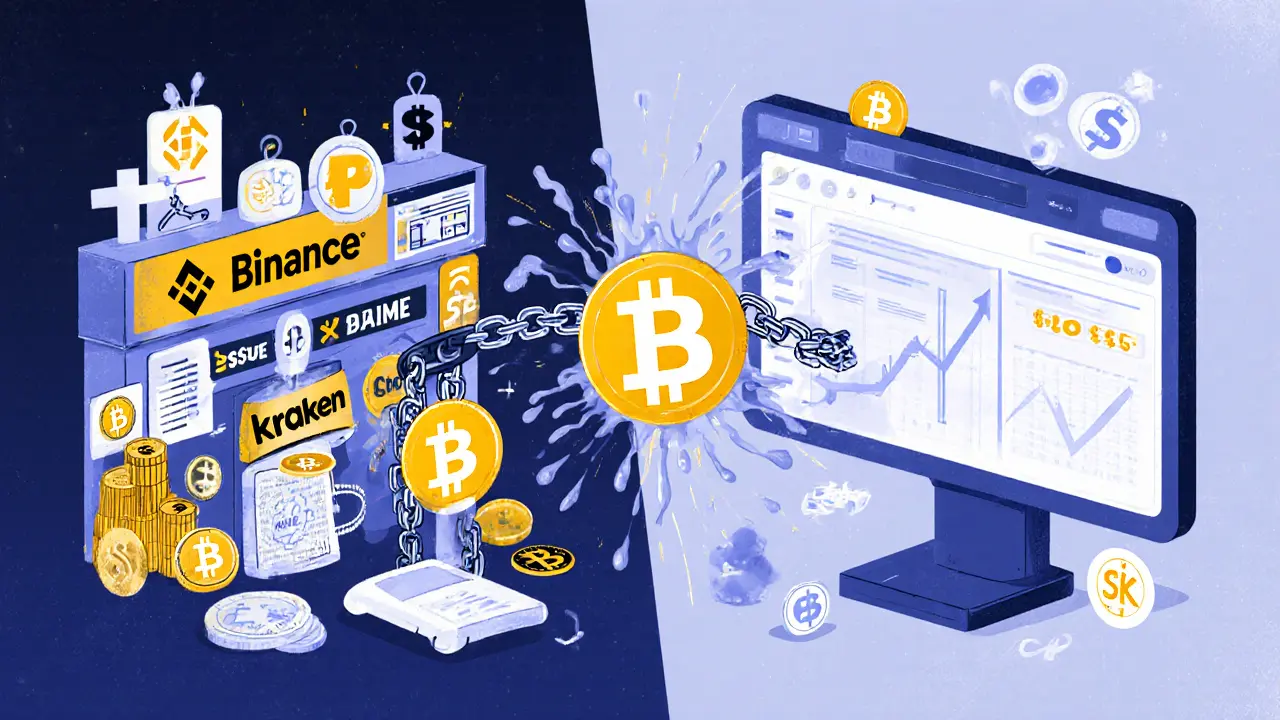Paradex Crypto Exchange Review: Zero Fees, Institutional Liquidity, and zk-Privacy in 2025

Paradex Margin Calculator
Margin Requirements Calculator
Risk Analysis
Note: With Paradex's unified margin system, your entire wallet balance acts as collateral across all positions. Higher leverage increases liquidation risk significantly.
Most crypto exchanges charge you every time you trade. Even the big ones-Binance, Bybit, Kraken-they all take a cut. But what if you could trade futures, options, and spot markets with zero fees? No maker-taker fees. No hidden costs. Just pure price action. That’s Paradex. And it’s not a gimmick-it’s the real deal, running on Starknet’s Layer 2 with zk-rollups, handling over $827 million in 24-hour volume as of November 2025.
What Makes Paradex Different?
Paradex isn’t just another DeFi exchange. It’s built from the ground up to solve the biggest problems traders face: high fees, slow execution, and zero privacy. Unlike GMX or Kwenta, which charge 0.1% to 0.15% per trade, Paradex charges 0%. That’s not a promo. That’s the default. And it’s sustainable because of its unique tokenomics and institutional backing. The platform runs on its own blockchain called DimeVM-a Starknet-based appchain optimized for derivatives. It’s not just faster than Ethereum; it’s faster than most centralized exchanges. Market orders fill in under 200ms. Order execution is near-instant. You’re not waiting for blocks to confirm. You’re trading like you’re on Binance, but with your keys in your wallet. And then there’s privacy. Most DeFi platforms broadcast your entire trading history on-chain. Every position, every liquidation, every profit or loss is public. Paradex changes that. Using zero-knowledge proofs, it masks your trades. Your entry price, leverage, and PnL are hidden from the public chain. Only you and your smart contract know the details. That’s something no other decentralized derivatives exchange offers at this scale.Trading on Paradex: Markets, Leverage, and Margin
Paradex supports 250+ trading pairs across perpetual futures, perpetual options, and spot markets. You can trade BTC, ETH, SOL, and even niche tokens like RSR or TIA with up to 50x leverage. That’s not just for whales-retail traders can start with $50 and go 50x if they want. But here’s the catch: you’re not risking your whole balance. The platform uses a unified margin system. Instead of locking up capital for each position, your entire wallet balance acts as collateral across all trades. That means if you’re long BTC and short ETH, your profits in one position can offset losses in another. It’s efficient. But it’s also risky. If the market swings hard, you could get liquidated faster than on isolated margin. That’s why experienced traders recommend starting with cross-margin and small positions. You can also trade options. As of November 1, 2025, Paradex launched perpetual options for 25 assets. No more waiting for expiration. No more complex strike prices. Just set your direction, leverage, and size-and trade like a pro. The UI shows real-time risk graphs, liquidation prices, and estimated fees (which are still $0).How Paradex Compares to the Competition
| Feature | Paradex | Hyperliquid | dYdX v4 | GMX |
|---|---|---|---|---|
| Trading Fees | 0% | 0.05% | 0.05% | 0.1% |
| Max Leverage | 50x | 50x | 20x | 50x |
| 24h Volume | $827M | $421M | $395M | $210M |
| Privacy Features | Yes (zk-account masking) | No | No | No |
| Chain Support | 20+ (Ethereum, Solana, Base, Arbitrum, etc.) | Ethereum | Ethereum | Ethereum |
| TPS Capacity | 10,000+ | 1,000 | 500 | 300 |
Paradex leads in volume, speed, and privacy. Hyperliquid and dYdX are strong in liquidity, but they’re still on Ethereum L1 or L2s with higher gas and slower execution. GMX is great for spot and perpetuals but lacks options and privacy. Paradex combines everything into one system.

The Tech Behind the Speed
Paradex isn’t just fast because it’s “new.” It’s fast because of DimeVM-their custom Layer 2 blockchain built on Starknet’s zk-rollup tech. Every trade, every liquidation, every margin update is proven mathematically correct using zero-knowledge proofs. Then, the final state is anchored to Ethereum. That means you get Ethereum-level security without Ethereum-level congestion. Gas fees? Almost zero. You pay a tiny amount in $DIME or USDC to cover the actual proof computation-but it’s less than $0.01 per trade. The system handles 10,000+ transactions per second. Compare that to dYdX, which maxes out at 500 TPS, or even Solana’s peak of 65,000 TPS (which often drops to 10,000 under load). Paradex maintains consistent performance even during market spikes. The $DIME token powers everything. It’s used for governance, staking, and fee discounts (though fees are already zero). Traders earn $DIME through the Season 2 airdrop by trading volume. Over 287,000 traders earned points by October 2025. That’s not just marketing-it’s a real incentive to use the platform.Who Is Paradex For?
If you’re a beginner, Paradex might feel overwhelming. The interface is clean, but the concepts-unified margin, RPI, STP, perpetual options-are advanced. Trustpilot reviews show users like “CryptoNewbie99” got liquidated because they didn’t understand how leverage worked across positions. That’s not the platform’s fault-it’s a user education gap. But if you’ve traded on Binance Futures or used GMX before, Paradex is a game-changer. You get the same tools, but faster, cheaper, and private. Reddit users like “DeFiTrader87” report filling 350 USDC BTC orders in 127ms. That’s faster than most centralized exchanges during peak hours. Institutional traders are also on board. Optiver, Akuna Capital, and Amber Group are backers. At least three hedge funds are using Paradex’s API for algorithmic strategies. That’s not something you see with every DeFi project.Drawbacks and Risks
No platform is perfect. Paradex’s biggest risk? It’s still new. Smart contracts have been audited by OpenZeppelin and least authority, but they haven’t been battle-tested in a full bear market. There’s no historical data on how the unified margin system holds up during black swan events. DeFi safety researcher Alex Chen warned in November 2025 that correlated risk exposure could trigger cascading liquidations. If BTC drops 20% and you’re long BTC, short ETH, and long SOL-all in unified margin-you could get wiped out faster than if each position was isolated. Also, block proposals are still centralized. A single operator (currently controlled by Paradex Labs) proposes blocks. That’s a temporary measure while they transition to a fully decentralized sequencer. It’s not a vulnerability-it’s a design choice for speed. But it’s a centralization risk until the full decentralization roadmap is complete. And of course, derivatives trading is inherently risky. 50x leverage can turn $100 into $5,000-or into $0. Paradex doesn’t sugarcoat this. Every trade screen shows your liquidation price in bold red. You’re not being lured in. You’re being warned.
Getting Started in 2025
Here’s how to start trading on Paradex:- Connect a wallet: MetaMask, Phantom, or WalletConnect.
- Bridge funds: Use the native bridge or third-party options like Across or Synapse to send USDC or other assets from Ethereum, Solana, or Base.
- Choose your market: Pick perpetual futures, options, or spot.
- Set your leverage: Start with 5x or 10x if you’re new.
- Use the margin calculator: It shows real-time liquidation risk.
- Place your order: Market or limit-either way, it fills instantly.
The onboarding tutorial takes 15 minutes. If you’ve traded before, you’ll be comfortable in 2-3 hours. If you’re new to derivatives, expect to spend 8-10 hours learning the mechanics. Paradex’s tooltips explain terms like “RPI” (Realized Price Impact) and “STP” (Smart Trade Parameters) right on the chart.
